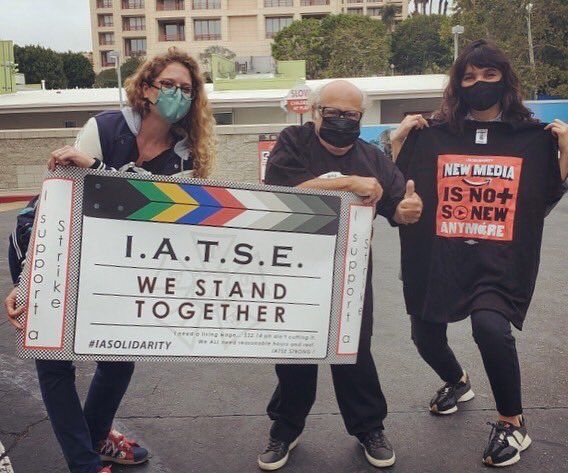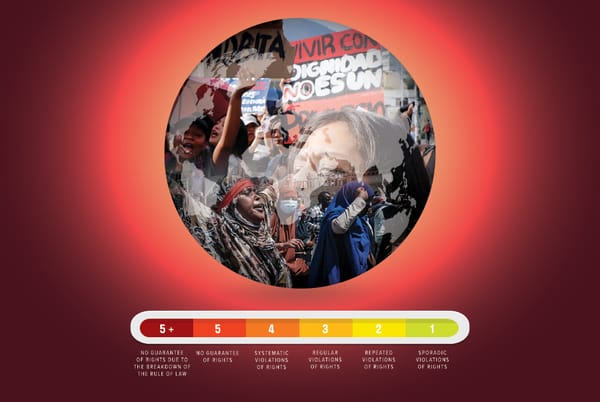
The International Alliance of Theatrical Stage Employees (IATSE) is on the cusp of calling a strike that could grind Hollywood to a halt. The international union representing many behind-the-scenes workers in film, television and live performance has been in a protracted struggle with the Alliance of Motion Picture and Television Producers (AMPTP) over a new three-year collective agreement.
IATSE’s previous collective agreement, the “Hollywood Basic Agreement,” was set to expire at the end of July, but was extended into September. However, continued negotiations between the union and employer association have failed to produce a new contract.
Key issues in this fight are living wages for all “below-the-line” employees and a new deal on residuals from streaming service productions. But perhaps most importantly, the union is seeking improvements in working conditions, particularly stricter working hours rules.
The lowest paid workers on many production sets receive a “minimum wage” that is well below a living wage in Los Angeles. Notoriously low base pay for new media and cultural workers prevents people from marginalized backgrounds from entering the industry. Higher minimum pay, across the media and cultural sectors, is therefore also an issue of equity and inclusion.
The union is also fighting to bring pay rates on streaming service productions such as Netflix up to the rates of other standard productions. Current collective bargaining agreement provisions allow lower rates on productions classified as “new media,” which is supposedly meant to ease the financial burden on new production companies or forms of media. As it stands, despite streaming services’ huge growth and recent Emmy Awards dominance, these companies are permitted to pay production workers at well below network rates, as well as avoid making health and pension plan contributions.
Although this “new media” loophole is meant to only apply to streaming services with fewer than 20 million subscribers, its very existence introduces precariousness into the lives of many production workers as streaming becomes the new industry norm.
The union quite rightly argues that streaming services should no longer qualify as “new media” and should be required to pay all production workers at standard rates.
Without a doubt, excessively long hours are the biggest issue that workers want to address. Fourteen-hour days and 60-hour weeks are not uncommon, and a lack of adequate rest between times on set is a perpetual bone of contention with workers. Many of Hollywood’s top cinematographers signed a letter to the AMPTP last month imploring them to address the practice of “hazardous and unsafe working hours,” noting that the health consequences of overwork and fatigue are serious and well-known.
IATSE members maintain that contractual penalties (basically overtime or “premium” pay) are not steep enough to deter studios and production companies from scheduling excessive hours. Firmer caps on daily hours and strict rest periods, both on set and between scheduled production days, are necessary to protect workers’ health and safety.
The AMPTP continues to maintain that its last bargaining offer addressed many key union concerns. However, the organization representing Hollywood studios and production companies also cites the “economic fallout” of the COVID-19 pandemic as reason for limiting the scope of its offer.
After AMPTP did not respond to the union’s latest package of bargaining proposals, on September 23 IATSE announced that they’d hold a nationwide strike authorization vote. The vote is set to take place on October 1. If members vote “yes,” this will be the first time production employees have gone on strike in Hollywood since the Second World War’s “Black Friday” strike. It will also be the first time ever that all West Coast IATSE locals have struck at the same time.
The very announcement of a strike authorization vote should demonstrate to AMPTP that the union is committed to making gains at the bargaining table. IATSE members are integral to the continued work of many highly profitable network and streaming service productions. From camera operators to script supervisors, it is impossible to maintain production without these union members. A strong “yes” vote could provide the necessary leverage to force AMPTP to cave to workers’ demands and ultimately avert a strike.
The pressure on the employers is particularly intense as production ramps up after previous shutdowns and delays during the pandemic. The union is in perhaps its most advantageous position yet and has an unprecedented opportunity to make gains for its members.
IATSE represents some 150,000 workers in more than 360 union locals in film, television and theatre across the United States and Canada, including writing assistants, script supervisors, production coordinators, technicians, designers and costumers, cinematographers, as well as many other “below-the-line” production workers in film and live performance. As I’ve covered in Class Struggle as well as in other venues, IATSE has also recently organized some of the most precarious artistic workers in the cultural sector, particularly in Canada.
In this particular fight with Hollywood and the streaming studios, 13 West Coast IATSE locals representing approximately 43,000 members could walk off the job and halt production across North America.
At the same time, the union is also in the process of negotiating its Area Standards Agreement covering regions outside of Los Angeles and New York. The two agreements together cover approximately 60,000 IATSE members. Talks here are in no better shape. IATSE announced recently that it would hold a second strike authorization across the 23 union locals covered under the Area Standards Agreement. If all 60,000 union members ultimately down their tools, it will be the biggest private sector strike in the United States in more than a decade.
The union operates through a system where delegate votes are apportioned according to the size of each local. This means that each of the 13 West Coast IATSE locals must have 75 per cent of voting members vote “yes” for its delegates to register support for the strike. If a majority of delegates return “yes” votes, the IATSE president Matthew Loeb can call the strike.
As Nellie Andreeva reports in Deadline, the union has been able to mobilize members in unprecedented ways, drawing on years of pent-up anger over low wages and awful working conditions in a hugely rich and profitable industry. Other Hollywood unions, including the Screen Actors Guild (SAG-AFTRA), the Directors Guild of America, the Writers Guild of America and the Teamsters have also expressed their solidarity with IATSE members.
The union campaign has additionally gained a sizable social media following. Twitter hashtags #IASolidarity and #IALivingWage, as well as the Instagram account @ia_stories, have provided online space for workers to connect and share personal stories about poor working conditions with one another and supporters. Horror stories of car accidents after 18 hour days and health issues stemming from being denied bathroom breaks have exposed a hidden reality of Hollywood exploitation.
These initial forays on social media contributed to the high level of solidarity among members on display now. Union members turned workplace issues that were prevalent across the industry, such as low pay and brutal hours, into matters of debate and discussion. In a sector where individual hustle and sacrifice in the name of art are common expectations, these online forums generated new space for solidarity. In fact, it is likely that the union’s bargaining focus on minimum pay, streaming service rates and working hours is a direct result of the rank-and-file emphasis on, and anger over, these key problems.
Many celebrities have also openly expressed their solidarity with, and support for, IATSE members, including Jane Fonda and Lily Tomlin, who snapped a photo in #IASolidarity t-shirts on the set of Netflix’s Grace and Frankie. Expressions of solidarity from Hollywood stars are more than just good media; they hopefully indicate that those with much greater power won’t cross a potential IATSE picket line. This extra pressure could prove hugely important to a union victory.
Although some studios are reportedly looking into “contingency plans,” such as postponing and rescheduling shooting and acquiring other completed series, IATSE’s threat of a labour withdrawal is very difficult to counter.
IATSE workers are realizing the collective power they hold. If a strike proves necessary, they deserve unconditional support and solidarity.







